Abstract
Cervical cancer incidence and mortality can be reduced by removal of precursor lesions detected at cytological screening. Organised screening, i.e. regular invitation of defined target groups, is generally considered more effective than opportunistic screening. The latter method however, is predominant in most settings. There is no scientific basis for advocating one type of screening or the other. Our aim was to compare the two types and to analyse their efficiency. We analysed 466,275 smears taken in an open cohort of 118,890 women during 1969-88. A computerised database permitted standardised classification of all smears and complete ascertainment of cancer in situ through record linkage. The number of in situ cancers detected per 1000 smears, the detection ratio, was used as an outcome measure both in univariate analyses and in multivariate logistic regression models. Cancer in situ was detected in 1076 women in the study cohort, with a detection ratio of 3.0 at organised and 2.1 at opportunistic screening, yielding an unadjusted odds ratio of 0.69 (95% CI 0.61-0.79). After adjustment for age and time period, the probability of detecting cancer in situ was around 25% higher with opportunistic than with organised screening (OR = 1.26; 95% CI 1.09-1.46). This difference in favour of opportunistic screening was most pronounced in the first 10 year period and disappeared during the last decade. The difference in efficiency between organised and opportunistic screening in the detection of cancer in situ was slight, if any. The dogma that organised screening is significantly more efficient than the opportunistic type needs reconsideration.
Full text
PDF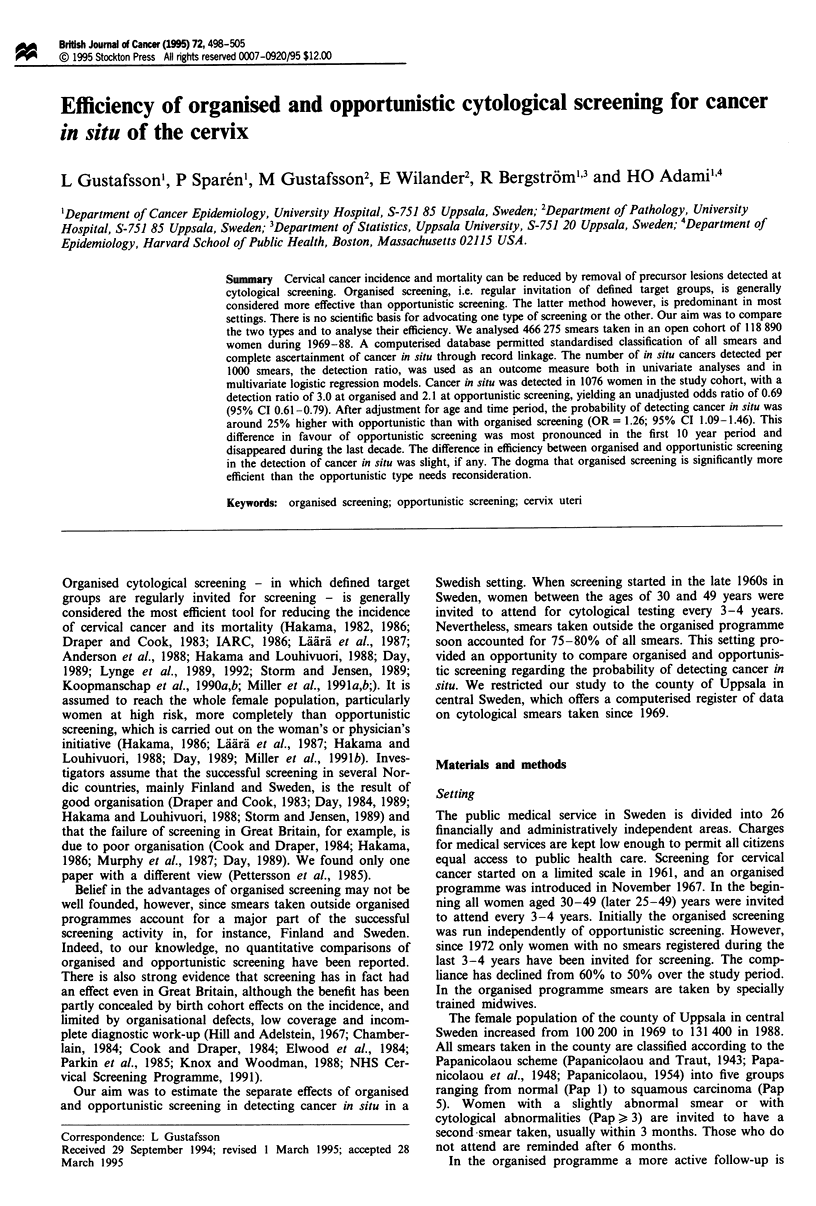
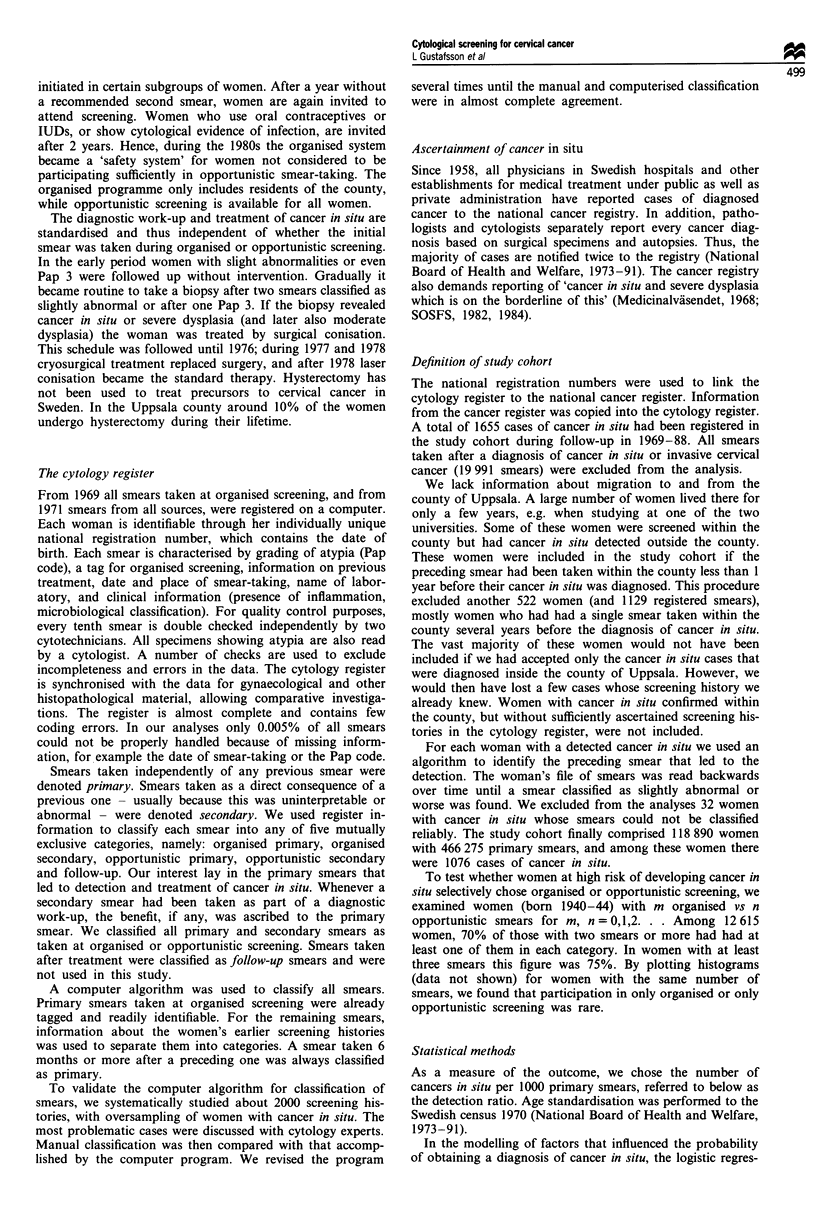
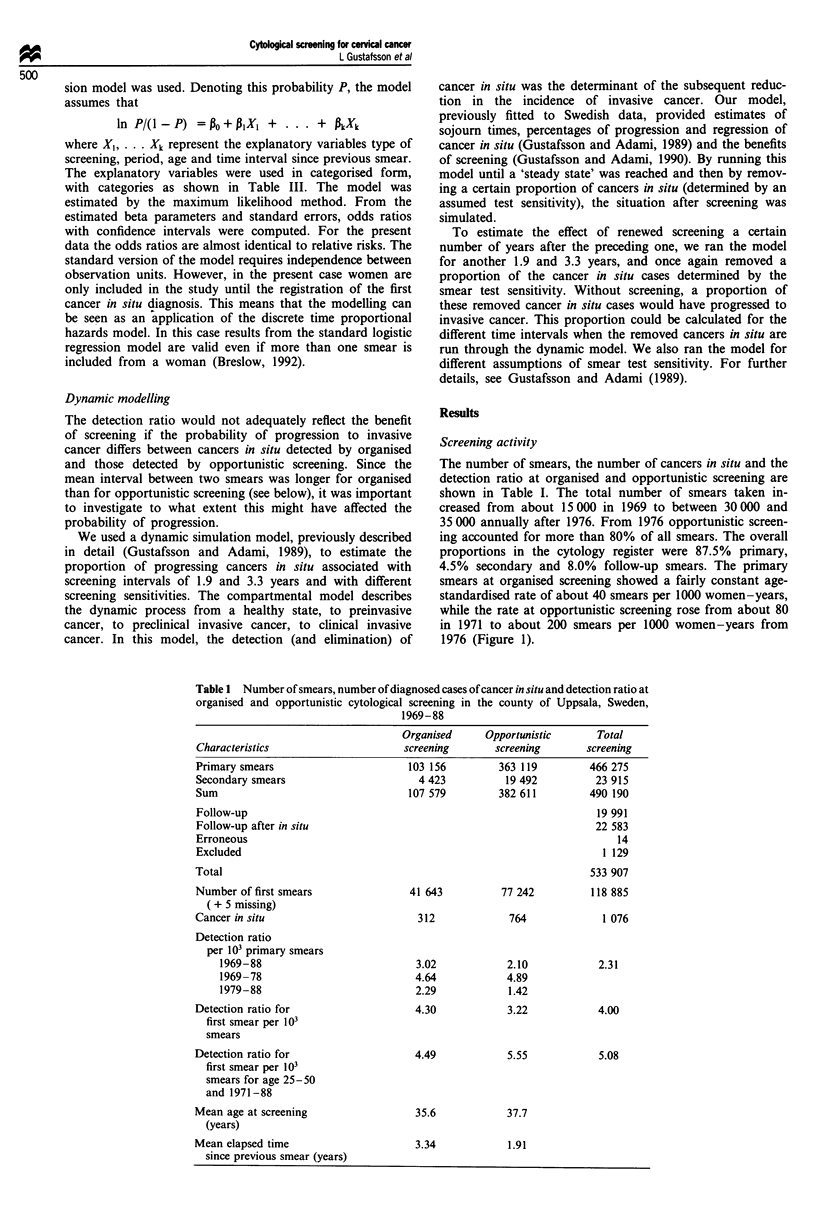
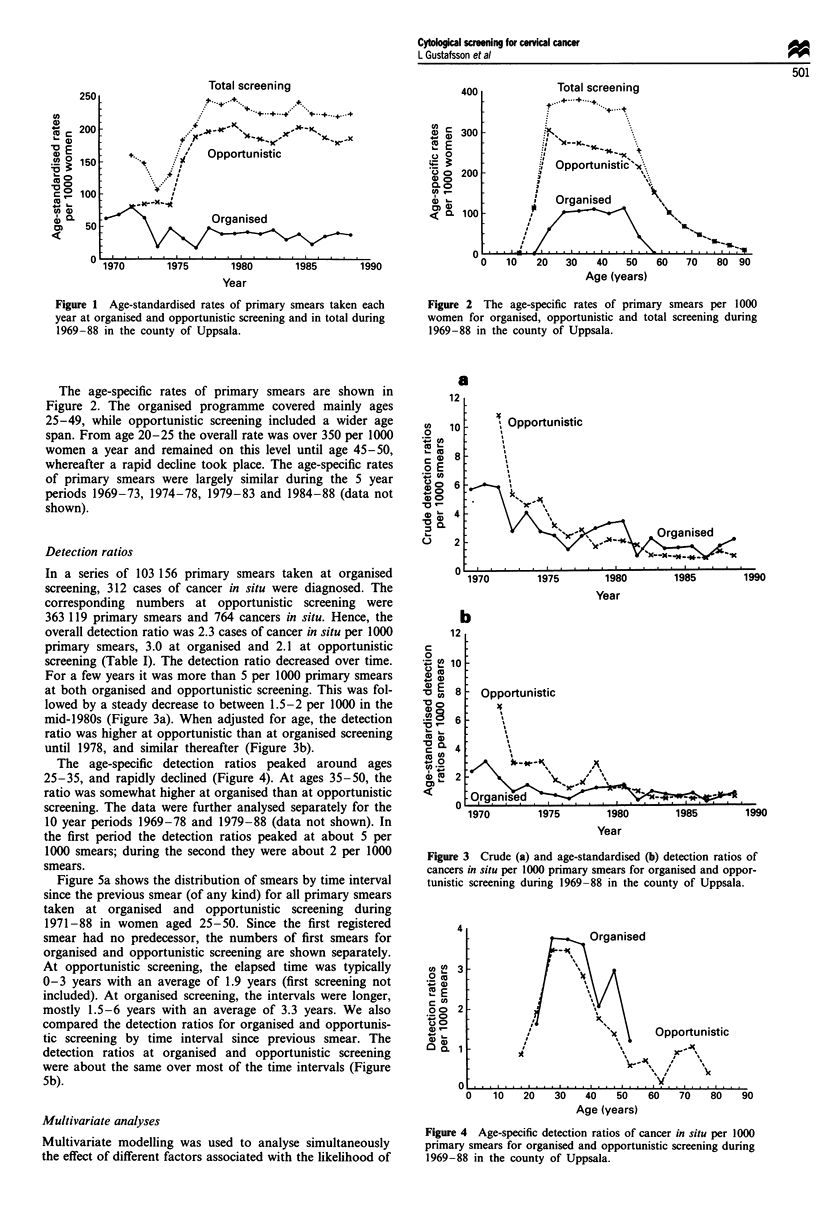



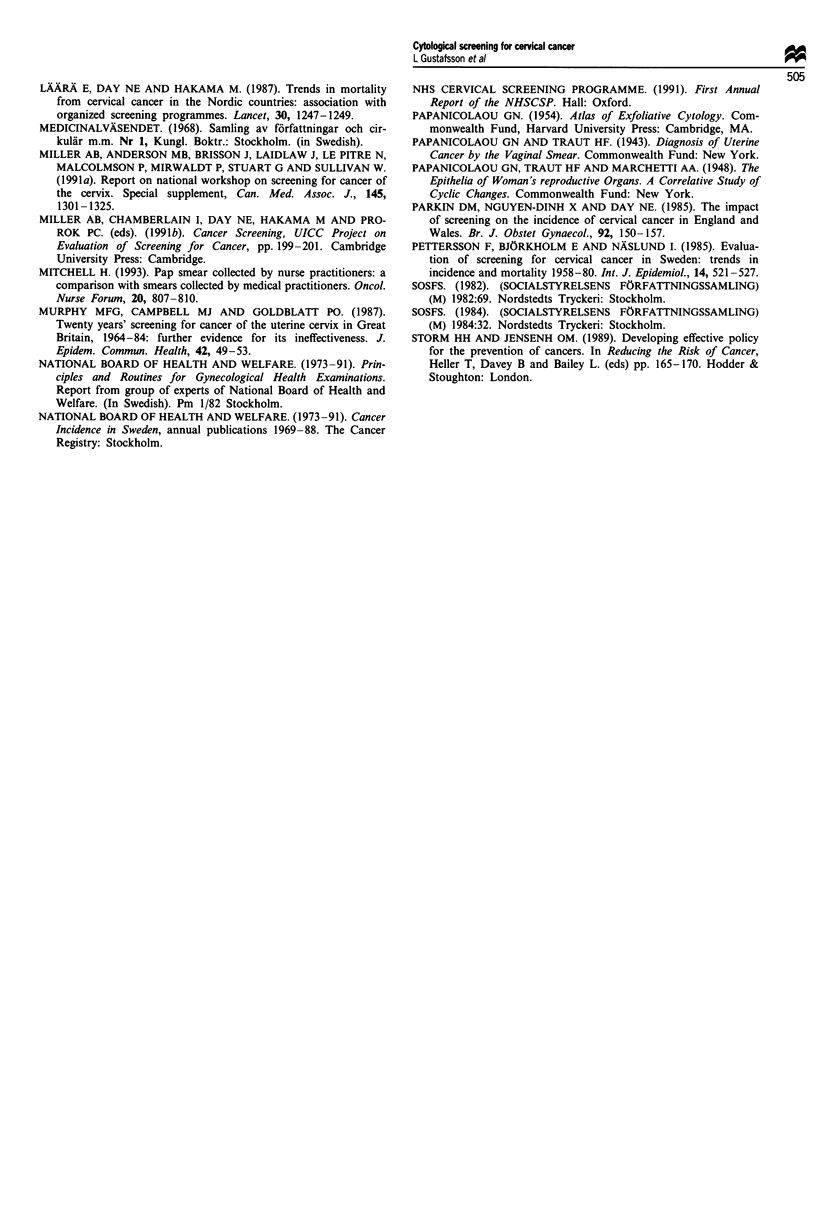
Selected References
These references are in PubMed. This may not be the complete list of references from this article.
- Ahlgren M., Lindberg L. G., Nordqvist S., Stormby N. G. Mass screening for cervical cancer with the aid of nurses and an administrative computer service. Acta Obstet Gynecol Scand. 1969;48(Suppl):58+–58+. doi: 10.3109/00016346909157708. [DOI] [PubMed] [Google Scholar]
- Anderson G. H., Boyes D. A., Benedet J. L., Le Riche J. C., Matisic J. P., Suen K. C., Worth A. J., Millner A., Bennett O. M. Organisation and results of the cervical cytology screening programme in British Columbia, 1955-85. Br Med J (Clin Res Ed) 1988 Apr 2;296(6627):975–978. doi: 10.1136/bmj.296.6627.975. [DOI] [PMC free article] [PubMed] [Google Scholar]
- Bergström R., Adami H. O., Gustafsson L., Pontén J., Sparén P. Detection of preinvasive cancer of the cervix and the subsequent reduction in invasive cancer. J Natl Cancer Inst. 1993 Jul 7;85(13):1050–1057. doi: 10.1093/jnci/85.13.1050. [DOI] [PubMed] [Google Scholar]
- Bhargava V. L., Verma K., Sharma R., Batra S., Anandalakshmy P. N. A hospital-based study on the use of paramedical personnel for clinical downstaging of cancer cervix. Indian J Med Res. 1993 Apr;98:65–68. [PubMed] [Google Scholar]
- Chamberlain J. Failures of the cervical cytology screening programme. Br Med J (Clin Res Ed) 1984 Oct 6;289(6449):853–854. doi: 10.1136/bmj.289.6449.853. [DOI] [PMC free article] [PubMed] [Google Scholar]
- Cook G. A., Draper G. J. Trends in cervical cancer and carcinoma in situ in Great Britain. Br J Cancer. 1984 Sep;50(3):367–375. doi: 10.1038/bjc.1984.185. [DOI] [PMC free article] [PubMed] [Google Scholar]
- Day N. E. Effect of cervical cancer screening in Scandinavia. Obstet Gynecol. 1984 May;63(5):714–718. [PubMed] [Google Scholar]
- Day N. E. Screening for cancer of the cervix. J Epidemiol Community Health. 1989 Jun;43(2):103–106. doi: 10.1136/jech.43.2.103. [DOI] [PMC free article] [PubMed] [Google Scholar]
- Draper G. J., Cook G. A. Changing patterns of cervical cancer rates. Br Med J (Clin Res Ed) 1983 Aug 20;287(6391):510–512. doi: 10.1136/bmj.287.6391.510. [DOI] [PMC free article] [PubMed] [Google Scholar]
- Elwood J. M., Cotton R. E., Johnson J., Jones G. M., Curnow J., Beaver M. W. Are patients with abnormal cervical smears adequately managed? Br Med J (Clin Res Ed) 1984 Oct 6;289(6449):891–894. doi: 10.1136/bmj.289.6449.891. [DOI] [PMC free article] [PubMed] [Google Scholar]
- Gustafsson L., Adami H. O. Cytologic screening for cancer of the uterine cervix in Sweden evaluated by identification and simulation. Br J Cancer. 1990 Jun;61(6):903–908. doi: 10.1038/bjc.1990.202. [DOI] [PMC free article] [PubMed] [Google Scholar]
- Gustafsson L., Adami H. O. Natural history of cervical neoplasia: consistent results obtained by an identification technique. Br J Cancer. 1989 Jul;60(1):132–141. doi: 10.1038/bjc.1989.236. [DOI] [PMC free article] [PubMed] [Google Scholar]
- Gustafsson L., Adami H. O. Optimization of cervical cancer screening. Cancer Causes Control. 1992 Mar;3(2):125–136. doi: 10.1007/BF00051652. [DOI] [PubMed] [Google Scholar]
- Hakama M., Louhivuori K. A screening programme for cervical cancer that worked. Cancer Surv. 1988;7(3):403–416. [PubMed] [Google Scholar]
- Hill G. B., Adelstein A. M. Cohort mortality from carcinoma of the cervix. Lancet. 1967 Sep 16;2(7516):605–606. doi: 10.1016/s0140-6736(67)90752-0. [DOI] [PubMed] [Google Scholar]
- Knox E. G., Woodman C. B. Effectiveness of a cancer control programme. Cancer Surv. 1988;7(3):379–401. [PubMed] [Google Scholar]
- Koopmanschap M. A., Lubbe K. T., van Oortmarssen G. J., van Agt H. M., van Ballegooijen M., Habbema J. K. Economic aspects of cervical cancer screening. Soc Sci Med. 1990;30(10):1081–1087. doi: 10.1016/0277-9536(90)90294-3. [DOI] [PubMed] [Google Scholar]
- Koopmanschap M. A., van Oortmarssen G. J., van Agt H. M., van Ballegooijen M., Habbema J. D., Lubbe K. T. Cervical-cancer screening: attendance and cost-effectiveness. Int J Cancer. 1990 Mar 15;45(3):410–415. doi: 10.1002/ijc.2910450305. [DOI] [PubMed] [Google Scholar]
- Lynge E., Engholm G., Madsen M. Organiseret screenings betydning for udviklingen af livmoderhalskraeft i Danmark i 1968-1987. Ugeskr Laeger. 1992 May 4;154(19):1330–1334. [PubMed] [Google Scholar]
- Lynge E., Madsen M., Engholm G. Effect of organized screening on incidence and mortality of cervical cancer in Denmark. Cancer Res. 1989 Apr 15;49(8):2157–2160. [PubMed] [Google Scholar]
- Lără E., Day N. E., Hakama M. Trends in mortality from cervical cancer in the Nordic countries: association with organised screening programmes. Lancet. 1987 May 30;1(8544):1247–1249. doi: 10.1016/s0140-6736(87)92695-x. [DOI] [PubMed] [Google Scholar]
- Miller A. B., Anderson G., Brisson J., Laidlaw J., Le Pitre N., Malcolmson P., Mirwaldt P., Stuart G., Sullivan W. Report of a National Workshop on Screening for Cancer of the Cervix. CMAJ. 1991 Nov 15;145(10):1301–1325. [PMC free article] [PubMed] [Google Scholar]
- Mitchell H. Pap smears collected by nurse practitioners: a comparison with smears collected by medical practitioners. Oncol Nurs Forum. 1993 Jun;20(5):807–810. [PubMed] [Google Scholar]
- Murphy M. F., Campbell M. J., Goldblatt P. O. Twenty years' screening for cancer of the uterine cervix in Great Britain, 1964-84: further evidence for its ineffectiveness. J Epidemiol Community Health. 1988 Mar;42(1):49–53. doi: 10.1136/jech.42.1.49. [DOI] [PMC free article] [PubMed] [Google Scholar]
- Parkin D. M., Nguyen-Dinh X., Day N. E. The impact of screening on the incidence of cervical cancer in England and Wales. Br J Obstet Gynaecol. 1985 Feb;92(2):150–157. doi: 10.1111/j.1471-0528.1985.tb01067.x. [DOI] [PubMed] [Google Scholar]
- Pettersson F., Björkholm E., Näslund I. Evaluation of screening for cervical cancer in Sweden: trends in incidence and mortality 1958-1980. Int J Epidemiol. 1985 Dec;14(4):521–527. doi: 10.1093/ije/14.4.521. [DOI] [PubMed] [Google Scholar]


